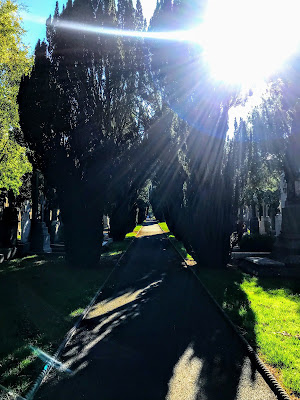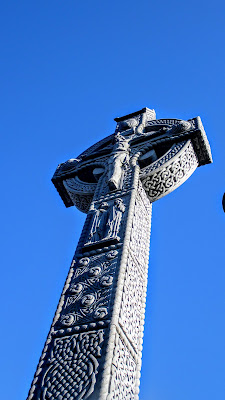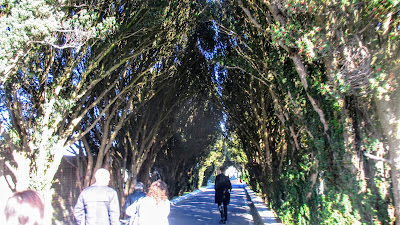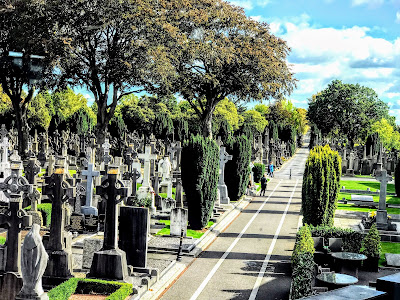Glasnevin
 In many cities around the world, visiting cemeteries can be a very enriching experience, and visiting the Glasnevin Cemetery in Dublin is not different. Until the 1800s the Irish (mostly Catholics) lived under the severe rules of what was called Penal Laws, which were restrictions and humiliations imposed by the UK to suppress dissidents and Catholics. And among those sanctions was the prohibition of burying the dead in cemeteries.
In many cities around the world, visiting cemeteries can be a very enriching experience, and visiting the Glasnevin Cemetery in Dublin is not different. Until the 1800s the Irish (mostly Catholics) lived under the severe rules of what was called Penal Laws, which were restrictions and humiliations imposed by the UK to suppress dissidents and Catholics. And among those sanctions was the prohibition of burying the dead in cemeteries. You could be buried in a graveyard and with a religious ceremony in Ireland only if you were a Protestant. This terrible situation changed from the initiative of one of Ireland's greatest political leaders, named Daniel O'Connell, known as The Liberator or The Emancipator, he had success on the Catholic emancipation in Ireland - without the use of violence. O'Connell wanted to create a space where every person (regardless of religion or with no religion at all) could have a dignified burial.
You could be buried in a graveyard and with a religious ceremony in Ireland only if you were a Protestant. This terrible situation changed from the initiative of one of Ireland's greatest political leaders, named Daniel O'Connell, known as The Liberator or The Emancipator, he had success on the Catholic emancipation in Ireland - without the use of violence. O'Connell wanted to create a space where every person (regardless of religion or with no religion at all) could have a dignified burial. And so came the Glasnevim Cemetery, in 1832 occurred the first burial, an 11-year-old boy. Since then more than 1.5 million people have been buried in this space, which began with 9 acres and today has more than 120 and is in continuous expansion. After the train track there is a large space known as St. Paul's which is the continuation of the cemetery.
And so came the Glasnevim Cemetery, in 1832 occurred the first burial, an 11-year-old boy. Since then more than 1.5 million people have been buried in this space, which began with 9 acres and today has more than 120 and is in continuous expansion. After the train track there is a large space known as St. Paul's which is the continuation of the cemetery. The idea from the beginning was to draw inspiration from other European cemeteries and to make of this place not only a place with tombstones and tombs, but a garden. The Glasnevin is designed in the same mold as a Victorian Garden. And it really is used by a lot of people to do walks like a park. It is even possible to see whole families walking there.
The idea from the beginning was to draw inspiration from other European cemeteries and to make of this place not only a place with tombstones and tombs, but a garden. The Glasnevin is designed in the same mold as a Victorian Garden. And it really is used by a lot of people to do walks like a park. It is even possible to see whole families walking there. In Glasnevin there are also many historical and cultural activities such as lectures and workshops for students, scholars, historians, etc. It is very interesting to walk around and appreciate the beauty of the place and contemplate the different styles of tombstones.
In Glasnevin there are also many historical and cultural activities such as lectures and workshops for students, scholars, historians, etc. It is very interesting to walk around and appreciate the beauty of the place and contemplate the different styles of tombstones. One-hour tours are offered where the guide provides a wealth of information about the cemetery and the history of Ireland. We already did the tour and liked it very much.
One-hour tours are offered where the guide provides a wealth of information about the cemetery and the history of Ireland. We already did the tour and liked it very much. There are buried many leaders, local celebrities, politicians, etc. One of the most visited is the political leader Michael Collins, who killed during the Irish civil war in 1922. There are also the politicians Eamon De Valera, Charles Parnell, Roger Casement, James Larkin, etc.
There are buried many leaders, local celebrities, politicians, etc. One of the most visited is the political leader Michael Collins, who killed during the Irish civil war in 1922. There are also the politicians Eamon De Valera, Charles Parnell, Roger Casement, James Larkin, etc.
 But in Glasnevin there is place also for those who were not even born alive. It is one of the few cemeteries that has a space for the stillborn called Angels Plot. Since 1982, cremations have also been carried out. Relatives can, if they wish, leave the urns in the graveyard, or even use The Waterum, which is a piece of bronze where ash is deposited and allowed to be gradually thrown back to the earth. In this building the cremations are made.
But in Glasnevin there is place also for those who were not even born alive. It is one of the few cemeteries that has a space for the stillborn called Angels Plot. Since 1982, cremations have also been carried out. Relatives can, if they wish, leave the urns in the graveyard, or even use The Waterum, which is a piece of bronze where ash is deposited and allowed to be gradually thrown back to the earth. In this building the cremations are made. In the visitor center there is a small souvenir shop.
In the visitor center there is a small souvenir shop. And also an interesting museum called City of Dead. You can see a short video about the history of the cemetery and learn many other details of how it all works. Even the treatment of water that is made so that contaminations do not occur. In the Wall of Memory there is a large panel with objects representing some of the people buried there.
And also an interesting museum called City of Dead. You can see a short video about the history of the cemetery and learn many other details of how it all works. Even the treatment of water that is made so that contaminations do not occur. In the Wall of Memory there is a large panel with objects representing some of the people buried there. In the museum also are shown the gravediggers that for a long time were essential for the good functioning of the place. Today burials are made by machines. There is also the explanation about body snatchers. In the 19th century, there was great interest in bodies for medical schools. Of course, with this strong demand came people who had the idea of stealing newly buried bodies. But the authorities prevented this from happening here and built large surveillance towers so that no body was removed from there. The instructions were to shoot if any such act were to be seen. And the measures worked. As far as we know, no body was stolen from Glasnevin.
In the museum also are shown the gravediggers that for a long time were essential for the good functioning of the place. Today burials are made by machines. There is also the explanation about body snatchers. In the 19th century, there was great interest in bodies for medical schools. Of course, with this strong demand came people who had the idea of stealing newly buried bodies. But the authorities prevented this from happening here and built large surveillance towers so that no body was removed from there. The instructions were to shoot if any such act were to be seen. And the measures worked. As far as we know, no body was stolen from Glasnevin. At the top of the museum there is also an exhibition and it is possible to have an overview of the place.
At the top of the museum there is also an exhibition and it is possible to have an overview of the place. There is also a full cafeteria with lots of choices of snacks, sandwiches, soups, coffees, pastries, etc.
There is also a full cafeteria with lots of choices of snacks, sandwiches, soups, coffees, pastries, etc. Of course, you must be curious to know Glanevin's most famous tomb, the founder of the cemetery, Daniel O'Connell.
Of course, you must be curious to know Glanevin's most famous tomb, the founder of the cemetery, Daniel O'Connell. It is possible to enter with a guide there. He gives us some information about this man who had a fighting life (not only for the Irish) and who died in Italy. He, who was a fervent Catholic, said that he wanted his body to stay in Ireland, heart in Rome and soul in heaven. The body is very well taken care of here, but the Italians did not know how to do the same with the heart of O 'Connell and nowadays no one knows where it is. Since 2018 you can also visit the highest Irish Round Tower (55 meters) built next to O'Connell's tomb.
It is possible to enter with a guide there. He gives us some information about this man who had a fighting life (not only for the Irish) and who died in Italy. He, who was a fervent Catholic, said that he wanted his body to stay in Ireland, heart in Rome and soul in heaven. The body is very well taken care of here, but the Italians did not know how to do the same with the heart of O 'Connell and nowadays no one knows where it is. Since 2018 you can also visit the highest Irish Round Tower (55 meters) built next to O'Connell's tomb. In the 1970s it suffered a bomb attack and remained closed to the public until this year. Today it is possible to climb the 198 steps to reach the top and have a beautiful view of part of the city and the cemetery. The climb is worth it on a sunny day.
In the 1970s it suffered a bomb attack and remained closed to the public until this year. Today it is possible to climb the 198 steps to reach the top and have a beautiful view of part of the city and the cemetery. The climb is worth it on a sunny day. And you must be tired of getting to know this huge graveyard, so why not stopping at the iconic Dublin pub "John Kavannagh", better known as "The Gravediggers", for there the gravediggers would take a few pints. Look at the photos, the pub is next to the graveyard.
And you must be tired of getting to know this huge graveyard, so why not stopping at the iconic Dublin pub "John Kavannagh", better known as "The Gravediggers", for there the gravediggers would take a few pints. Look at the photos, the pub is next to the graveyard. The guides tell us that there was a little door between the pub and the graveyard where the gravediggers would beat their shovels and a pint was left there so that it was not necessary to leave the job. The pub is very simple but very traditional and is always full.
The guides tell us that there was a little door between the pub and the graveyard where the gravediggers would beat their shovels and a pint was left there so that it was not necessary to leave the job. The pub is very simple but very traditional and is always full. And if you are still prepared for another walk, next to Glasnevin is Ireland's beautiful Botanical Garden.
And if you are still prepared for another walk, next to Glasnevin is Ireland's beautiful Botanical Garden.
Labels
HISTORY






























































































Post A Comment
Nenhum comentário :